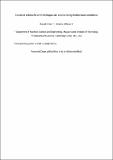Nutrient release from K-feldspar ore altered in hydrothermal conditions
Author(s)
Ciceri, Davide; Allanore, Antoine
DownloadAccepted version (972.5Kb)
Terms of use
Metadata
Show full item recordAbstract
© 2019, Institute of Chemistry, Slovak Academy of Sciences. The development of potash materials from local K-bearing resources such as aluminosilicate minerals is desirable to overcome reliance on imported fertilizers in tropical countries. However, the nutrient release from such materials follows a time-dependent profile that is not well-understood and that is significantly different if probed at agronomic or geological timescales. This work investigates the nutrient release from a calcium–aluminum–silicate-hydrate (C–A–S–H) material obtained via hydrothermal alteration of K-feldspar ore and CaO. The C–A–S–H hydrothermal material is subjected to sequential leaching cycles with diluted HNO3 (initial pH = 5), renewing the leaching solution at every cycle. X-Ray Powder Diffraction (XRD) is used to monitor changes in the material mineralogy as the leaching progresses, showing a relative increase of calcite (up to 7 wt%) and amorphous phase (up to 23 wt%). Inductively Coupled Plasma Mass Spectrometry (ICP-MS) of the leachates is used to monitor the release of K, Ca, Si and Al, and shows that the material releases K nutrient at every leaching cycle. The pH of the leachates shows that as the content of calcite in the material increases a buffering capacity at pH ≈ 9.6 is developed by the material. The mineralogy, nutrient release, and pH results presented in this study suggest a potential application of the material as a slow release fertilizer when compared to KCl. Experimental results also imply that kinetic parameters rather than solubility are more suited to describe the fertilizer value of silicate materials.
Date issued
2020Department
Massachusetts Institute of Technology. Department of Materials Science and EngineeringJournal
Chemical Papers
Publisher
Springer Science and Business Media LLC